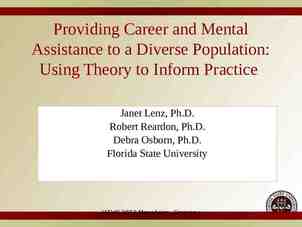Ms. Tarver 6th Grade Science
15 Slides1.66 MB

Ms. Tarver 6th Grade Science

Phenomenon: Storm Clouds (refer to the previous lesson) Reference: Textbook pages 472-475 Resources: Cloud Facts for Kids YouTube video Cloud Watchers Worksheet

Objective: I can analyze and interpret data in order to show patterns in clouds and cloud formations. Standard: 6.ESS2.5 Analyze and interpret data from weather conditions, weather maps, satellites, and radar to predict probable local weather patterns and conditions. Science and Engineering Practice: Analyzing and Interpreting Data Cross Cutting Concept: Patterns and Energy and Matter

Cloud Dew point Stratus cloud Cumulus cloud Cirrus cloud

o o o A cloud is a collection of small water droplets or ice crystals that are suspended in the air. Clouds are visible because water droplets and ice crystals reflect light. The precipitation that falls from clouds has a significant effect on local climate. In particular, the pattern of precipitation of an area will determine the climate of that area.

Clouds also affect temperatures on Earth. About 25% of the sun’s energy that reaches Earth is reflected back into space by clouds. Low-altitude clouds, which are thick and reflect more sunlight, help to cool Earth. Thin, high-altitude clouds absorb some of the energy that radiates from Earth. Part of this energy is reradiated back to Earth’s surface and warms Earth.

Dew point is the temperature at which the rate of condensation equals the rate of evaporation.

Solar energy drives the water cycle and, therefore, provides the energy for cloud formation. Wind causes clouds to move around Earth’s surface. However, for air to be cooled to its dew point so that clouds can form, the air is pushed up, or is lifted, into the atmosphere.

The three classes of clouds are: Stratus clouds Cumulus clouds Cirrus clouds.

Stratus clouds are thin and flat, and their edges are not clearly defined. They are the lowest clouds in the atmosphere and are often gray. Stratus clouds merge into one another and may look like a single layer that covers the entire sky. Fog is a type of stratus cloud.

Cumulus clouds are thick and puffy on top and generally flat on the bottom. They have well-defined edges and can change shape rapidly. Some cumulus clouds are high in the atmosphere, so the top of cloud appears flattened. Fair-weather cumulus clouds are bright and white. Cumulus clouds, however, can become dark as more and more water droplets or ice crystals are added to the cloud. Cumulus clouds can also produce severe weather.

Cirrus clouds look feathery and their ends curl. Cirrus clouds are white and form high in the atmosphere. Where cirrus clouds form, there is little water vapor and temperatures are very cold. Therefore, they are made of ice crystals. Cirrus clouds do not produce precipitation that reaches Earth’s surface.

Watch Cloud Facts For Kids video on YouTube. https://youtu.be/EhLT11hKyok Look outside at the clouds in the sky. Use the Cloud Watchers sheet and your record data. You can check www.weather.com or call (901) 526-5261 to get the temperature at the time that you look at the clouds. You may use other sources as well. Remember, however, always cite where you received your information from.

Based on your research of clouds, explain the relationship between clouds, temperature, and precipitation.







